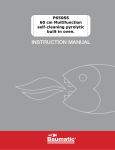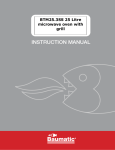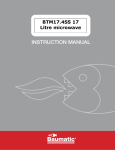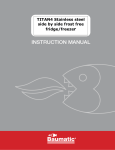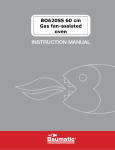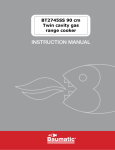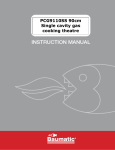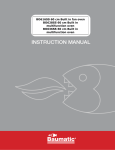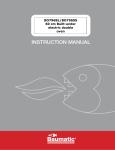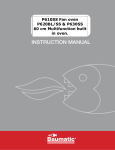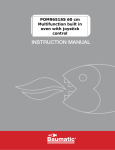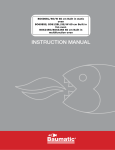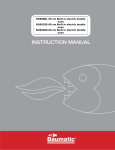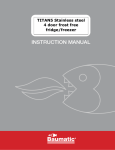Download Baumatic BO788SS
Transcript
BO788SS 60 cm Built under twin cavity gas oven .. 1 User Manual for your Baumatic BO788SS 60 cm Built under twin cavity gas oven NOTE: This User Instruction Manual contains important information, including safety & installation points, which will enable you to get the most out of your appliance. Please keep it in a safe place so that it is easily available for future reference; for you or any person not familiar with the operation of the appliance. DD 14/06/10 2 Contents Environmental note Important safety information 4 5–8 Specifications Product specifications Standard accessories Optional extra Electrical details Gas details Cooling fans Description of the oven Control panel Oven programmer/timer 9 - 13 9 10 10 10 10 10 11 - 12 12 13 Initial set-up of your oven Setting the time of day Before first use 13 – 14 13 14 Timer functions The minute minder function Cancelling the minute minder function Adjusting the volume of the audible signal Changing the time of day 15 – 16 15 15 16 16 Using your gas oven Switching the gas oven on Switching the gas grill on Cooking guidelines Warnings Gas mark temperatures Cooking table Slow cooking Roasting guide 17 17 18 19 20 21 21 22 22 - 22 18 19 20 Cleaning and maintenance Replacing the oven bulb Removing the oven door for cleaning (main oven only) Removing the inner door glass for cleaning (main oven only) 22 23 24 25 - 26 24 25 26 Installation Electrical connection Positioning Installing the oven into the kitchen cabinet Positioning the appliance Installation between two separate cabinet units Installation between two side panels and one cabinet unit Ventilation requirements Gas connection Room ventilation requirements Gas Safety (Installation and Use) Regulations Gas connection Gas adjustment (Conversion to LPG and gas adjustment) Regulating the oven burner minimum setting Substituting the grill burner 27 27 28 29 29 30 31 32 32 33 34 34 35 37 38 - 39 - 28 My appliance isn’t working correctly Contact details 39 - 40 41 - 30 - 33 - 35 – 37 - 38 - 39 3 Environmental note o The packaging materials that Baumatic uses are environmentally friendly and can be recycled. o Please discard all packaging material with due regard for the environment. 4 IMPORTANT SAFETY INFORMATION Your safety is of the utmost importance to Baumatic. Please make sure that you read this instruction booklet before attempting to install or use the appliance. If you are unsure of any of the information contained in this booklet, please contact the Baumatic Advice Line. General Information o This appliance is designed for domestic household use and can be built under a standard worktop. o IMPORTANT: The adjacent furniture or housing and all materials used in the installation must be able to withstand a minimum temperature of 85°C above the ambient temperature of the room it is located in, whilst in use. o Certain types of vinyl or laminate kitchen furniture are particularly prone to heat damage or discolouration at temperatures below the guidelines given above. o Any damage caused by the appliance being installed in contravention of this temperature limit, or by placing adjacent cabinet materials closer than 4mm to the appliance, will be the liability of the owner. o For use in leisure accommodation vehicles, please refer to the appropriate information given in the installation instructions for this appliance. o IMPORTANT: Baumatic Ltd. DO NOT recommend that this appliance is installed on any type of marine vessel. o The use of this appliance for any other purpose or in any other environment without the express agreement of Baumatic Ltd. will invalidate any warranty or liability claim. o Your new appliance is guaranteed against electrical or mechanical defects, subject to certain exclusions that are noted in Baumatic’s Conditions Of Guarantee. The foregoing does not affect your statutory rights. o Repairs may only be carried out by Baumatic service engineers or their authorised service agent. 5 Warning and safety instructions o This appliance complies with all current European safety legislation. Baumatic do wish to emphasise that this compliance does not remove the fact that the appliance surfaces will become hot during use and retain heat after operation. Child Safety o Baumatic strongly recommend that babies and young children are prevented from being near to the appliance and not allowed to touch the appliance at any time. During and after use, all surfaces will become hot. o If it is necessary for younger family members to be in the kitchen, please ensure that they are kept under close supervision at all times. General Safety o Make sure that you understand the controls before using the appliance. o Check that all of the controls on the appliance are switched off after use. o Always stand back when opening the oven door, this will allow heat to disperse. o Take care when removing items from the oven, as the contents may be hot. o Always keep the oven door closed when the oven is not in use. o Always follow the basic principles of food handling and hygiene; this will prevent the possibility of bacterial growth. o Always keep ventilation slots clear of obstructions. o Keep fingers away from the hinge areas when closing the door, otherwise you may trap them. o Oven gloves should be used when placing food in the oven cavity and when removing it. Care should be taken to avoid direct contact with either of the burners in the appliance. o DO NOT LEAVE THE APPLIANCE UNATTENDED WHILST IN USE. 6 o Do not place heavy objects on the oven door or lean on the oven door when it is open, as this can cause damage to the oven door hinges. Nobody should be allowed to sit or stand on any part of the oven. o Do not heat up unopened food containers, as pressure can build up which may cause the container to burst. o Do not place flammable or plastic items in the oven. o Do not leave heated oil or fat unattended, as this is a fire risk. o Do not allow fat or oil to build up in the oven trays, enamelled baking tray or oven base. o Do not place pans or baking trays directly on the base of the oven cavity, or line it with aluminium foil. o Do not grill food containing fat without using the grill trivet. The grill trivet should never be covered with aluminium foil. o Do not place hot enamel parts in water, leave them to cool first. o Do not allow vinegar, coffee, milk, saltwater, lemon, tomato juice or any liquid with high sugar content to remain in contact with the enamel parts of the appliance. Spillages should be wiped up immediately. o Do not allow electrical fittings or cables to come into contact with areas on the appliance that get hot. o Do not use the appliance to heat the room it is located in or to dry clothing. No clothing should be placed over or near to the oven door. o Do not install the appliance next to curtains or soft furnishings. o Do not attempt to lift or move cooking appliances by using the oven door or handle, as this may cause damage to the appliance or result in injury to the person lifting the appliance. o Do not store chemicals, food stuffs, pressurised containers in or on the oven or in cabinets immediately above or next to the oven. 7 Cleaning o Cleaning of the oven should be carried out on a regular basis. o Great care should be taken whilst using this appliance and when following the cleaning procedure. o IMPORTANT: The appliance must be disconnected from the mains before following the cleaning procedure. Installation This appliance must be correctly installed by a suitably qualified person, strictly in accordance with the manufacturer’s instructions. Please see the specific section of this booklet that refers to installation. o Baumatic Ltd. declines any responsibility for injury or damage, to person or property, as a result of improper use or installation of this appliance. o Heat, steam and moisture will be created during use of the appliance, take care to avoid injury and ensure that the room is adequately ventilated. If the appliance is going to be used for prolonged periods of time, then additional ventilation may be required. o Please consult with your qualified installer if you are in any doubt about the amount of ventilation that you will require. Declaration of conformity This appliance complies with the following European Directives: -73/23/EEC regarding “low voltage” -89/336/EEC regarding “electromagnetic disturbances” -90/396/EEC regarding “gas appliances” -89/109/EEC regarding “materials in contact with food”. o The above directives comply with 93/68/EEC regarding CE marking. o The manufacturer declares that the oven is built using certified materials and requires the appliance to be installed in accordance with the standards currently in force. This appliance must be used by a trained person for domestic purposes only. 8 Specifications A = Location of fixing screws. Product Dimensions Aperture Dimensions Height: Width: Depth: Height: Width: Depth: 716 mm 598 mm 547 mm 720 mm MIN 560 mm MIN 560 mm MIN Product specifications: o o o o o o o LED minute minder 2 Cooling fans Flame failure safety device (oven and grill) Auto-ignition Gas oven with lower burner Gas grill Double-glazed removable doors o Upper cavity: grill only o Oven capacity: 31 litres o Lower cavity: gas oven o Oven capacity: 43 litres 9 Standard accessories: o o o o o Removable side racks 2 x Safety shelves 2 x Enamelled baking trays with handle Trivet LPG conversion jets Optional extra: o BPS2 Pizza stone Electrical details: Rated Voltage: Supply Connection: Fuse rating: Max Rated Inputs: Mains Supply Lead: 230 Vac 50 Hz 13 A (double pole switched fused outlet with 3mm contact gap) 3 amp 0.09 kW 3 x 1.5 mm² Gas details: Connection: Type: Rp ½ (ISO R7) Natural Gas (20.9 mbar) Alternative LPG G30 (28-30 mbar) Cooling fans o Two tangential cooling fans are fitted inside of this appliance, to make the internal temperature of the oven stable and the external surface temperature lower. o After you have finished cooking and switched off the oven, the cooling fan will continue to run for a period of time afterwards. The length of time will depend on how long the oven has been switched on for and at how high a temperature. 10 For future reference please record the following information which can be found on the rating plate and the date of purchase which can be found on your sales invoice. The rating plate for your oven can be located by opening the oven door and looking on the frame of the main oven chassis. Model Number ………………………………. Serial Number ………………………………. Date of Purchase ………………………………. Description of the oven 1) 2) 3) 4) 5) Grill burner Main oven burner Oven grill (main and top) Drip tray for grill cooking Drip tray for main oven cooking 11 Accessories Main oven: Top oven: o Position the accessories (drip tray or grill) in the correct support levels as shown in the images above. Control Panel 1 2 3 4 - Gas grill control knob Gas oven control knob Oven timer LED display 12 Oven programmer/timer 1 2 3 4 5 = = = = = Decimal point symbol Minute minder symbol Programme button Minus button Plus button Initial set-up of your oven Setting the time of day After your appliance is connected to your mains supply for the first time, you must set the time of day before you can use the oven. o When the oven is connected to your mains supply for the first time (or after a power cut), the digits on the LED display will flash. o Press and hold down the programme button (3) for a couple of seconds and the digits will remain steady. o Whilst the decimal point symbol (1) is flashing, use the plus (5) and minus (4) buttons to set the correct time of day. o When the correct time of day is shown on the LED display, release the plus and minus buttons and wait a few seconds. The decimal point symbol will stop flashing and the oven is ready to use. 13 Before first use o To remove any residue from the cavities that may have been left from the manufacturing process, you should set the gas oven to its maximum temperature setting. The gas grill should be set separately to its maximum temperature setting. o It is perfectly normal for a smell to be produced during this process. o You should make sure that any windows in the room are left open during this process. o It is advisable for you not to remain in the room whilst the burning off process is taking place. o You should leave the oven and grill on maximum setting for 30 – 40 minutes. o IMPORTANT: You simultaneously. should not burn off both cavities o After both cavities have cooled, they should then be cleaned with warm soapy water, using either a sponge or soft cloth. No abrasive cleaners should be used. o Outer parts of the oven should be cleaned with warm soapy water, using either a sponge or soft cloth. No abrasive cleaners should be used. o We would recommend that an appropriate stainless steel cleaner and polish is regularly used on the stainless steel surfaces of this appliance. 14 Timer functions The minute minder function The minute minder function is a countdown time that can be set on the oven programmer/timer. When the countdown time has finished, an audible signal will sound. o Press and hold down the programme button (3) until the decimal point starts to flash to enter programming mode. o Use the plus (5) and minus (4) buttons to set the countdown time that you require. o The maximum countdown time that can be set is 23 hours and 59 minutes. o When the correct countdown time appears on the LED display, release the plus and minus buttons and the countdown will start immediately. o After a few seconds the LED display will return to showing the time of day. o At the end of the countdown time, an audible signal will sound and the oven in use symbol will go out. The audible signal will sound for 7 minutes before switching off or you can silence it by pressing any of the oven programmer/timer buttons. o IMPORTANT: If the oven or grill is in use whilst using the minute minder function, they WILL NOT switch off at the end of the countdown time. YOU MUST turn the gas oven and/or gas grill control knobs to their OFF positions. Cancelling the minute minder function o Press and hold down the programme button (3) until the decimal point starts to flash to enter programming mode. o Press and hold down the minus (4) and plus (5) buttons simultaneously. o The minute minder symbol (2) will go out. o IMPORTANT: If you do not turn the gas oven and/or gas grill control knobs to their OFF positions, when you reset the timer function, it will continue to heat. 15 Adjusting the volume of the audible signal The volume of the audible signal has 3 levels, low, medium and high. To adjust the volume, you should proceed as follows:o IMPORTANT: The oven timer/programmer must not be in countdown mode. o Press and hold down the minus (4) and plus (5) buttons simultaneously until the decimal point starts to flash. o Press the programme button (3) and the LED display will show “n” followed by a number. 1 is the loudest volume, 2 is the middle volume and 3 is the quietest volume. o Use the minus button to select the volume level that you desire. Changing the time of day o IMPORTANT: The oven timer/programmer must not be in countdown mode. o Press and hold down the minus (4) and plus (5) buttons simultaneously until the decimal point starts to flash. o Release these buttons and then use the minus and plus buttons to alter the time of day. 16 Switching the gas oven on The oven has automatic ignition, to light it you should do the following:o Open the oven door. o Push the gas oven control knob down slightly and then turn it anticlockwise to the word MAX. o Whilst it is pointed to the MAX. position, fully push down this knob and hold it down. o The gas oven should light within 15 seconds. o Once the burner has lit, continue to keep the gas oven control knob held down for a further 10 seconds. Otherwise the safety cut off will operate and block the flow of gas. o IMPORTANT: When you are certain that the oven burner is fully lit, close the oven door. Then turn the gas oven control knob clockwise until it reaches the temperature that you desire. o DO NOT turn the control knob past the MIN position, otherwise the burner may go out. o If the gas oven does not light within 15 seconds, then release the gas oven control knob. o IMPORTANT: YOU MUST TURN THE CONTROL KNOB BACK TO ITS ORIGINAL POSITION; OTHERWISE GAS WILL CONTINUE TO BE RELEASED. o Wait for 1 minute, before repeating the ignition procedure again. When lighting your oven for the first time, it may take several times until the electric ignition operates. This is due to air being in the gas pipe. o The drip tray must not be placed above the level indicated in the diagram below to avoid burning the food. 17 o IMPORTANT: If there is a power cut whilst the oven is in use, the cooling fans will not operate. You should immediately turn the appliance off until power is restored. Switching the gas grill on The grill has automatic ignition, to light it you should do the following:o Open the grill door o Push the gas grill control knob down slightly and then turn it anticlockwise to the word MAX. o Whilst it is pointed to the word MAX, fully push down this knob and hold it down. o The gas grill should light within 15 seconds. o Once the burner has lit, continue to keep the gas grill control knob held down for a further 10 seconds. Otherwise the safety cut off will operate and block the flow of gas. o IMPORTANT: When you are certain that the grill burner is fully lit; turn the gas grill control knob clockwise until it reaches the setting that you desire. o If the gas grill does not light within 15 seconds, then release the gas grill control knob. IMPORTANT: YOU MUST TURN THE 18 CONTROL KNOB BACK TO ITS ORIGINAL POSITION; OTHERWISE GAS WILL CONTINUE TO BE RELEASED. o Wait for 1 minute, before repeating the ignition procedure again. When lighting your grill for the first time, it may take several times until the electric ignition operates. This is due to air being in the gas pipe. o In order to cook with the grill, use the drip tray and griddle. The drip tray should be placed above the main griddle and slid all the way in as in the illustration below: o IMPORTANT: If there is a power cut whilst the grill is in use, the cooling fans will not operate. You should immediately turn the appliance off until power is restored. Cooking guidelines o Please refer to the information given on food packaging for guidance on cooking temperatures and times. Once familiar with the performance of your appliance, temperatures and times can be varied to suit personal preference. o Preheat the oven for at least 15 minutes, before placing food into the cavity. o Preheat the grill for 5 – 10 minutes, before placing food into the cavity. o Make sure that frozen foods are thoroughly thawed before cooking, unless the instructions on the food packaging advise that you can “cook from frozen”. o Before cooking, check that any unused accessories are removed from the oven. 19 o Place cooking trays in the centre of the oven and leave gaps between the trays to allow air to circulate. o Try to open the door as little as possible to view the dishes. Warnings o Keep the oven door open when using the grill function and make sure that the grill deflector is fitted. o Do not use aluminium foil to cover the enamelled baking tray or heat items wrapped in aluminium foil under the grill. o You should also never line the base of your oven with aluminium foil. o During cooking, never place pans or cookware directly onto the bottom of your oven. They should always be placed on the shelves provided. o The grill becomes extremely hot during operation, avoid touching it inadvertently when handling the food which you are grilling. o Important: Be careful when opening the door, to avoid contact with hot parts and steam. o The enamelled baking tray handle should only be used to reposition the tray and NOT for removing it from the oven cavity. When removing the enamelled baking tray, you should ALWAYS use an oven glove. o The enamelled baking tray handle should not be left in position when the appliance is switched on. IMPORTANT: Air will vent from the top of the lower oven door. Care should be taken to ensure that NOTHING obstructs the flow of air coming from this area (as shown in the diagram opposite). 20 Gas mark temperatures Gas mark Degrees Fahrenheit Degrees Centigrade ¼ 225 110 ½ 250 130 1 275 140 2 300 160 3 325 170 4 350 180 5 375 190 6 400 200 7 425 220 8 450 230 9 475 240 Cooking table Main oven: Small cakes Whisked sponge Swiss roll Victoria sandwich (2 x 205 mm/8” Shallow tins) Semi-rich fruit cake (230 mm/9” deep tin) Scones Meringues Short crust pastry Puff/flake pastry Choux pastry Biscuits Bread (500 g/1 lb loaf) Sponge pudding Milk pudding Temperature (°C) 170 – 180 170 190 170 Approximate cooking time 140 2 ½ - 3 ½ hours 210 – 220 110 200 210 200 160 – 200 210 10 – 15 minutes 2 – 3 hours Cooking times for pastry dishes depend on the size and type of cooking dish and also the filling 10 – 20 minutes 20 – 30 minutes 150 150 45 minutes – 1 hour 1 ½ - 1 ¾ hours 20 – 25 minutes 15 – 20 minutes 8 – 12 minutes 25 – 35 minutes Grill: Shelf position High position Centre position Low position Food Toast, pike lets/crumpets, bacon, thin sausages, beef burgers, tomato halves, steak (rare and medium), Kipper, gammon, kidneys and toasted snacks. Toast, toasted snacks, thick sausages, beef burgers, fish fingers, steak (well done), gammon and chops (with heat turned down for part of the cooking time). Whole fish, fish fillets and fish steaks (on base of pan) and chicken portions (with heat turned down for part of the cooking time). 21 Slow cooking o IMPORTANT: Make sure that frozen foods are thoroughly thawed before cooking them. o DO NOT slow cook joints of meat or poultry weighing more than 2 ¼ kg (4 ½ lb). Roasting guide o Frozen meat should be thoroughly thawed before cooking. For larger joints, it is advisable to thaw overnight. o Frozen poultry should be thoroughly thawed before cooking; the time required depends on the size of the bird. For example, a large turkey may take up to 48 hours to thaw. o Adjust the shelf position, so that the meat or the poultry will be in the centre of the oven. o When roasting joints of meat or poultry and for pot roast, preheat the oven to 190 – 200°C and cook for 30 minutes. Then adjust the oven control to 110 - 120°C for the remainder of the cooking time. o Slow cooking times will be about three times as long as conventional cooking. Cleaning and maintenance Cleaning operations must only be carried out when the oven is cool. The appliance should be disconnected from your mains supply before commencing any cleaning process. o The oven should be thoroughly cleaned before it is operated for the first time and after each use. This will avoid residual food stuffs becoming baked on the oven cavity. After residues have been baked on several times, they are far more difficult to remove. o Never clean the oven surfaces by steam cleaning. o The oven and grill cavity should only be cleaned with warm soapy water, using either a sponge or soft cloth. No abrasive cleaners should be used. 22 o Any stains that may appear on the bottom of the oven will have originated from food splashes or spilt food, these splashes occur during the cooking process. These could possibly be a result of the food being cooked at an excessively high temperature or being placed in cookware that is too small. o You should select a cooking temperature that is appropriate for the food that you are cooking. You should also ensure that the food is placed in an adequately sized dish and that you use the enamelled baking tray where appropriate. o Outer parts of the oven should only be cleaned with warm soapy water, using either a sponge or soft cloth. No abrasive cleaners should be used. o We would recommend that an appropriate stainless steel cleaner and polish is regularly used on the stainless steel surfaces of this appliance. o If you use any form of oven cleaner on your appliance, then you must check with the manufacturer of the cleaner that it is suitable for use on your appliance. o Any damage that is caused to the appliance by a cleaning product will not be fixed by Baumatic free of charge, even if the appliance is within the guarantee period. Replacing the oven bulb IMPORTANT: The oven must be disconnected from your mains supply before you attempt to either remove or replace the oven bulb. 23 o Remove the protective cover (A) by unscrewing it in an anticlockwise direction. o Remove the bulb (B) by turning it in an anti-clockwise direction. o Replace the bulb with a 25 W/300°C, screw type pigmy. o Do not use any other type of bulb. o Reassemble the protective cover (A). Removing the oven door for cleaning (main oven only) To facilitate the cleaning of the inside of the oven and the outer frame of the oven, the door can be removed as follows:o The hinges (A) have two movable bolts on them (B). o If you raise both of the movable bolts (B), then the hinges (A) are released from the oven housing. o You should grip the sides of the door at the centre and then incline it slightly towards the oven cavity and then pull it gently away from the oven cavity. o IMPORTANT: You should make sure that the door is supported at all times and that you place the door on some padded material whilst cleaning it. 24 o The oven door and door glass should only be cleaned using a damp cloth and a small amount of detergent. The cloth MUST NOT have come into contact with any form of cleaning product or chemical previously. o To refit the door you should slide the hinges back into their slots and open the door fully. o IMPORTANT: The movable bolts (B) must be closed back into their original positions before closing the door. o Take care not to dislodge the hinge locking system when removing the door, as the hinge mechanism has a strong spring. o Do not immerse the door in water at any time. Removing the inner door glass for cleaning (main oven only) o To facilitate cleaning, the door glass can be lifted out. o Open the door of the oven to a 45° angle. o There is a plastic sealing section at the top of the oven door, which has 4 small slots in it. 25 o Place a coin horizontally into one of the small slots and rotate the coin clockwise. You will feel part of the plastic sealing section disengage from the door. o Repeat this process for the other three slots and you will be able to lift the plastic sealing section away from the top of the door. o This will allow you to access the inner door glass. Carefully lift the door glass slightly at the top of the oven door and then slide the door glass towards you, removing it from the oven door. o IMPORTANT: Be careful to note which way around the oven door glass sits inside the oven door. YOU MUST put the door glass back into the oven door the same way around. o IMPORTANT: Care must be taken when cleaning between the door glasses, and inside the inner frame as some of the edges maybe sharp due to the manufacturing process. o Do not use any abrasive cleaner that could cause damage. o Remember that if the surface of the glass panel becomes scratched, this could lead to a dangerous failure. o When refitting, slide the inner door glass back into the oven door. IMPORTANT: Ensure that the glass sits properly in the recess at the base of the oven door and that it is the same way around as it was originally. o Refit the plastic sealing section to the top of the oven door, pushing it downwards to clip it back into position. 26 Installation The installation must be carried out by a suitably qualified person, in accordance with the current version of the following. o UK Regulations and Safety Standards or their European Norm Replacements. o Building Regulations (issued by the Department of the Environment). o Building Standards (issued by the Scottish Development Department). o IEE Wiring Regulations. o Electricity At Work Regulations. o Gas Safety (Installation and Use) (Amendment) Regulations. WARNING: THIS APPLIANCE MUST BE EARTHED. o This appliance should be wired into a 13 A double pole switched fused spur outlet, having 3 mm contact separation and the fuse rating reduced to 3 amps. This should be placed in an easily accessible position adjacent to the appliance, preferably above worktop level. An outlet can then be located at the rear of the appliance for connection. o To connect the oven power cord, loosen and remove the cover on the terminal block, in order to gain access to the contacts inside. Make the connection, securing the cord in place with the cable clamp provided and then immediately close the terminal block cover again. o If you have to change the oven power cord, the earthing (yellow/green) conductor must always be 10 mm longer than the line conductors. 27 o Care must be taken to ensure that the temperature of the mains supply cable does not exceed 50°C. o If the mains supply cable is damaged, then it must be replaced by an appropriate replacement. Positioning The adjacent furniture and all materials used in the installation must be able to withstand a minimum temperature of 85°C above the ambient temperature of the room it is located in, whilst the appliance is in use. o Your appliance is heavy, so you should be careful when moving or positioning it. o Do not try to move the cooker by pulling on either the door, handle or control panel. o The oven may be located in a kitchen, or a bedroom, but not in a room containing a bath or shower. The oven must not be installed in a bedroom of less than 20m³ in size. o LPG models must not be installed in a room or internal space below ground level (e.g. in a basement). o This oven is only designed to be installed as a built under appliance, using the brackets supplied. IMPORTANT: It must not be installed into a tall housing unit, at eye level. 28 Installing the oven into the kitchen cabinet Positioning the appliance o Ensure that the aperture that you will be fitting the oven into is of the size given in the above diagram. o The oven must be fitted into an oven housing with the ventilation cut-outs shown in the “Ventilation requirements” section on page 31. o Ensure that the rear panel of the furniture housing unit has been removed. o The side panels of the kitchen unit(s) must be full length and go all the way down to the floor. o If your kitchen units are on legs, then you must fit full length side panels to the side of the units that the support brackets will screw into, before commencing the installation process. 29 o IMPORTANT: Before installing the appliance into the housing unit, YOU MUST attach the “drip catcher” to the lower front edge of the oven using the 3 screws supplied. The above line drawing shows how you attach the “drip catcher”. Installation between two separate cabinet units o Measure a distance of 717 mm from the underside of the work top and mark the position of the lower support brackets. o Fix the lower support brackets in this position to the side of the cabinet units. They need to be positioned 40 mm back from the front edge of the cabinet units o Mark the position of the side support brackets, ensuring that they are also positioned 40 mm back from the front edge of the cabinet units. Fix the side support brackets into position. o Gently slide the oven back onto the lower support brackets and fix the oven to the front frame of the cabinets by using the four screws provided. 30 Installation between two side panels and one cabinet unit o Measure a distance of 717 mm from the underside of the work top and mark the position of the lower support brackets. o Fix the lower support brackets in this position to the side panels of the cabinet unit. They need to be positioned 40 mm back from the front edge of the side panels. o Gently slide the oven back onto the lower support brackets and fix the oven to the front frame of the cabinet by using the four screws provided. 31 Ventilation requirements IMPORTANT: The ventilation requirements shown in the above drawing MUST be followed; otherwise the oven may not operate correctly. Gas connection This appliance must be installed by a competent person in accordance with the current versions of the following UK (United Kingdom) or ROI (Republic of Ireland) Regulations and Safety Standards or their European Norm Replacements. Important information o This oven is supplied to run on natural gas only and cannot be used on any other type of gas without modification. o Conversion for use on LPG and other gases must only be undertaken by a qualified person. For information on the use of other gases, please contact the Baumatic Advice Line. 32 o The oven must be installed by a qualified person, in accordance with the current edition of the Gas Safety (Installation and Use) Regulations and the relevant building/I.E.E. Regulations. o Failure to install the appliance correctly could invalidate Baumatic’s guarantee and lead to prosecution under the regulations quoted above. o In the UK, only GASSAFE registered installers are authorised to undertake the installation and service work, in compliance with the above regulations. Room ventilation requirements o The room containing the oven should have an air supply in accordance with the current edition of BS 5440: Part 2: o The room must have opening windows or equivalent; some rooms may also require a permanent vent. o If the room has a volume between 5 and 10m³, it will require an air vent of 50cm² (effective area). Unless it has a door which opens directly to the outside. o If the room has a volume of less than 5m³, it will require an air vent of 100cm² (effective area). o If there are any other fuel burning appliances in the same room the current edition of BS 5440: Part 2: should be consulted to determine air vent requirements. o Ensure that the room containing the oven is well ventilated, keep natural ventilation holes. o Prolonged intensive use of the appliance may call for additional ventilation. o This oven is not fitted with a device for discharging the products of combustion. Ensure that the ventilation rules and regulations are followed. o Your oven must stand on a flat surface so that when it is in position the oven is level. When in position check that the oven is level by using a spirit level. o Remember that the quantity of air necessary for combustion must never be less than 2m³/h for each kW of power (see total power in kW on the appliance rating plate). 33 Gas Safety (Installation and Use) Regulations o It is a legal requirement that all gas appliances are installed by competent persons in accordance with the current edition of the Gas Safety Installation and Use Regulations. o For reasons of safety, it is in your best interests to ensure compliance with the law. o In the UK, GASSAFE registered installers work to safe standards of practice. The cooker must also be installed in accordance with the current edition of BS 6172. Failure to install the oven correctly could invalidate the warranty, liability claims and lead to prosecution. Gas connection ALL INSTALLATION AND SERVICE WORK MUST BE CARRIED OUT BY A GASSAFE REGISTERED ENGINEER. o Prior to installation, ensure that the gas supply conditions (nature of the gas and gas pressure) and the adjustment conditions are compatible. The adjustment conditions for this appliance are stated on the rating plate which can be found on the back cover. o This appliance is not designed to be connected to a combustion product evacuation device. Particular attention should be given to the relevant requirements regarding ventilation. o A ½” BSP female to female gas elbow (not supplied) should be connected to the gas inlet at the rear of the appliance and pointing in a downward direction. As indicated in the diagram opposite. o IMPORTANT: FIBRE WASHERS MUST BE USED WHEN CONNECTING THE GAS ELBOW (AS SHOWN IN THE ABOVE DIAGRAM). o Connection to the cooker should be made with an approved appliance flexible connection to BS 669. 34 o If the cooker has been converted for use with LPG, then it should be connected to the gas supply using an appropriate bayonet type hose. The hose MUST be suitable for use with LPG gas, these are identifiable by a red band or stripe. o A hose length of 0.9m to 1.25m is recommended. The length of hose chosen should be such that when the cooker is in situ, the hose does not touch the floor. o Care should be taken to ensure that the temperature rise of areas at the rear of the cooker that are likely to come in contact with the flexible hose do not exceed 70°C. o IMPORTANT: On completion carry out a gas tightness test. Gas adjustment (Conversion to LPG and gas adjustment) IMPORTANT: Your appliance must be disconnected from the electric and gas supply before completing this process. Burner Oven Grill Types of gas Pressure (mbar) Natural (G20) Butane (G30) Propane (G31) Natural (G20) Butane (G30) Propane (G31) 20 Injector Marking (1/100 mm) 115 28 - 30 73 37 73 20 115 28 – 30 73 37 73 Power (kW) Max. Min. Primary air gap (mm) 2.40 0.70 2.5 2.40 1.60 2.5 o Open the door of the lower cavity fully. 35 o Remove the oven burner shield from inside of the oven. o Remove the burner by moving the restraint spring to the left and sliding the burner out of its housing. In order to slide it out, lift up the left side and then slide it over to the left. In doing so, take care not to change the position of the igniter and safety device which are attached to the burner. o Unscrew and remove the injector. Replace with the injector which corresponds to the new gas type (please refer to the table above). It is recommended that the appropriate thread sealant is used; always check for gas tightness after assembly. o Put the oven burner back together, taking care not to change the position of the igniter and safety device which are attached to the burner. Replace the flame guard. 36 o Ensure that the appliance is in a safe condition, and then reconnect it to the electricity supply. Regulating the oven burner minimum setting o Open the oven door fully and ignite the oven burner. You should set the oven to maximum temperature, then close the oven door and leave the appliance for 10 – 15 minutes. o Reduce the temperature to its minimum setting and remove the gas oven control knob. o DISCONNECT THE APPLIANCE FROM THE ELECTRICITY SUPPLY. o Remove both the control knobs. o Unscrew the by-pass screws using a screwdriver. In order to regulate the minimum setting, it is only necessary to unscrew the by-pass screws by a few degrees when changing from liquid gas (G30/G31) to methane gas (G20). In order to function with G30/G31 the by-pass regulation screws must be screwed right down. o Refit the control knob, then turn it to the Max. position and then back to Min. several times, checking that the flame is maintained. o Fully open and close the oven door several times and check that the flame is maintained. If the flame is maintained, then switch the oven burner off. o Reconnect the oven to the electricity supply. 37 o IMPORTANT: It is now necessary to carry out a full function test of the appliance (this should include a gas tightness test). Substituting the grill burner IMPORTANT: Your appliance must be disconnected from the electric and gas supply before completing this process. o Open the oven door completely. Remove the grill burner attachment screws at the end of the burner (on the right side). o Remove the burner by moving it towards the right and sliding it off the support which props up the left side of the muffle, until the injector is uncovered. In doing so, take care not to change the position of the igniter and safety device which are attached to the burner. o Unscrew the remove the injector and replace with the injector which corresponds to the new gas type (see the table on page 31). 38 o Put the oven burner back together, taking care not to change the position of the igniter and safety device which are attached to the burner. My appliance isn’t working correctly The gas oven burner or grill burner do not light. * Check that the oven is switched on at your mains supply. * Check that the fuse in the spur outlet doesn’t need replacing. * Check that there is not a problem with your gas supply Food is cooking too quickly or too slowly. * Check that you are cooking at an appropriate temperature and shelf level. The oven is not cooking evenly. * Check that the oven is installed correctly. * Check that you are cooking at an appropriate temperature and shelf level. The oven light does not work. * Follow the “Replacing the oven bulb” section on page 23. I am getting condensation in my oven. * Steam and condensation is a natural by product of cooking any food with high water content, such as frozen food, chicken etc. * You may get condensation in the oven cavity and forming between the oven door glasses. This is not necessarily a sign that the oven is not working correctly. * Do not leave food in the oven to cool after it has been cooked and the oven has been switched off. * Use a covered container, where practical, when cooking to reduce the amount of condensation that forms. 39 IMPORTANT: If your appliance appears not to be operating correctly, then you should disconnect it from your mains supply and then contact Baumatic Customer Care on telephone number (0118) 933 6911. DO NOT ATTEMPT TO REPAIR THE APPLIANCE YOURSELF. Please note that if an engineer is asked to attend whilst the product is under guarantee and finds that the problem is not the result of an appliance fault, then you may be liable for the cost of the call out charge. The appliance must be accessible for the engineer to perform any necessary repair. If your appliance is installed in such a way that an engineer is concerned that damage will be caused to the appliance or your kitchen, then he will not complete a repair. This includes situations where appliances have been tiled in, sealed in with sealant, have wooden obstructions placed in front of the appliance, like plinths. Or any installation other than the one specified by Baumatic Ltd. has been completed. Please refer to the conditions of guarantee that appear on the warranty card that you receive with the appliance. IMPORTANT: Baumatic Ltd. operates a policy of continuous improvement and reserves the right to adjust and modify its products without prior notification. 40 United Kingdom Baumatic Ltd., Baumatic Buildings, 6 Bennet Road, Reading, Berkshire RG2 0QX United Kingdom Sales Telephone (0118) 933 6900 Sales Fax (0118) 931 0035 Customer Care Telephone (0118) 933 6911 Customer Care Fax (0118) 986 9124 Spares Telephone (01235) 437244 Advice Line Telephone (0118) 933 6933 E-mail: [email protected] [email protected] [email protected] [email protected] Website: www.baumatic.co.uk Republic of Ireland Service Telephone 1-890 812 724 Spares Telephone 091 756 771 Czech Republic Baumatic CR spol s.r.o. Průmyslová zóna Sever 696 460 11 Liberec 11 Czech Republic +420 483 577 200 www.baumatic.cz Slovakia Baumatic Slovakia, s.r.o. Galvániho 7/D Slovakia +421 255 640 618 Germany Baumatic Gmbh Lilienthalstrasse 1 320 52 Herford Deutschland +49 5221 694 99-0 www.baumatic.de Italy Baumatic Italia S.R.L. Via Galvani N.3 35011 Campodarsego (PD) +3904 9920 2297 www.baumatic.it Holland Baumatic Benelux B.V. Grindzuigerstraat 22 1333 MS ALMERE Nederland +3136 549 1555 www.baumatic.nl 41 42 43 44












































